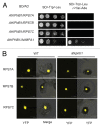The function of importin β1 is conserved in eukaryotes but the substrates may vary in organisms
- PMID: 23733071
- PMCID: PMC3999071
- DOI: 10.4161/psb.25106
The function of importin β1 is conserved in eukaryotes but the substrates may vary in organisms
Abstract
Importin β1 is the nuclear-cytoplasmic transport receptor in eukaryotic cells. Its main function is to transport NLS (nuclear localization signal)-containing proteins from cytoplasm to nucleus. Our recent study found that AtKPNB1, a homolog of the human KPNB1, is an essential component of the classical nuclear import of the NLS-containing proteins in Arabidopsis and modulates plant development and ABA-mediated stress response. Human KPNB1 can also directly transport the nuclear proteins, such as ribosomal protein RPS7e, without the intervention of importin α proteins. However, we found that AtKPNB1 does not directly recognize and import the human RPS7e homologous proteins AtRPS7A, AtRPS7B and AtRPS7C into the nucleus like human KPNB1. These findings suggest that the importin β1 protein has the conserved function in translocating nuclear proteins to the nucleus, but their specific cargos may vary in different organisms.
Keywords: Arabidopsis thaliana; NLS-containing protein; importin α; importin β1; nuclear-cytoplasmic transport.
Figures


Similar articles
-
An Arabidopsis homolog of importin β1 is required for ABA response and drought tolerance.Plant J. 2013 Aug;75(3):377-89. doi: 10.1111/tpj.12207. Epub 2013 May 13. Plant J. 2013. PMID: 23582042
-
KPNB1, XPO7 and IPO8 mediate the translocation ofNF-κB/p65 into the nucleus.Traffic. 2013 Nov;14(11):1132-43. doi: 10.1111/tra.12097. Epub 2013 Aug 19. Traffic. 2013. PMID: 23906023
-
Probing formation of cargo/importin-α transport complexes in plant cells using a pathogen effector.Plant J. 2015 Jan;81(1):40-52. doi: 10.1111/tpj.12691. Epub 2014 Nov 17. Plant J. 2015. PMID: 25284001 Free PMC article.
-
Importin alpha: a multipurpose nuclear-transport receptor.Trends Cell Biol. 2004 Sep;14(9):505-14. doi: 10.1016/j.tcb.2004.07.016. Trends Cell Biol. 2004. PMID: 15350979 Review.
-
Nucleocytoplasmic protein transport and recycling of Ran.Cell Struct Funct. 1999 Dec;24(6):425-33. doi: 10.1247/csf.24.425. Cell Struct Funct. 1999. PMID: 10698256 Review.
Cited by
-
Orientia tsutsugamushi uses two Ank effectors to modulate NF-κB p65 nuclear transport and inhibit NF-κB transcriptional activation.PLoS Pathog. 2018 May 7;14(5):e1007023. doi: 10.1371/journal.ppat.1007023. eCollection 2018 May. PLoS Pathog. 2018. PMID: 29734393 Free PMC article.
References
Publication types
MeSH terms
Substances
LinkOut - more resources
Full Text Sources
Other Literature Sources
Molecular Biology Databases
